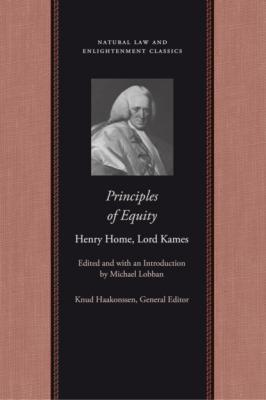ТОП просматриваемых книг сайта:
Principles of Equity. Henry Home, Lord Kames
Читать онлайн.Название Principles of Equity
Год выпуска 0
isbn 9781614872634
Автор произведения Henry Home, Lord Kames
Жанр Философия
Серия Natural Law and Enlightenment Classics
Издательство Ingram
[print edition page i]
PRINCIPLES OF EQUITY
[print edition page ii]
NATURAL LAW AND
ENLIGHTENMENT CLASSICS
Knud Haakonssen,
General Editor
[print edition page iii]
[print edition page iv]
[print edition page v]
[print edition page vi]
This book is published by Liberty Fund, Inc., a foundation established to encourage study of the ideal of a society of free and responsible individuals.
The cuneiform inscription that serves as our logo and as a design element in Liberty Fund books is the earliest-known written appearance of the word “freedom” (amagi), or “liberty.” It is taken from a clay document written about 2300 B.C. in the Sumerian city-state of Lagash.
Introduction, editorial apparatus, and index © 2014 by Liberty Fund, Inc.
Cover art (detail): Portrait of Henry Home, Lord Kames, by David Martin. Reproduced with permission of the National Galleries of Scotland.
This eBook edition published in 2015.
eBook ISBNs:
978-1-61487-263-4
978-1-61487-639-7
[print edition page vii]
CONTENTS
A Note on Legal Sources and Citations
Preliminary Discourse (from the second edition of Principles of Equity)
Principles of Equity, The Third Edition
Preface to the Present [Third] Edition
Table of Contents (Third Edition)
Explanation of Some Scotch Law Terms Used in This Work
Principles of Equity (Third Edition)
Volume 2
Original Index (index to the 1778 edition)
Principles Founded on in This Work
Major Variant Readings between the First, Second, and Third Editions
[print edition page viii]
Table of Contents of the First Edition (1760)
Table of Contents of the Second Edition (1767)
Appendix: Extracts from the First and Second Editions
Letter from Kames to Robert Dundas of Arniston, Lord President of the Court of Session, Including a Paper Entitled “Jurisdiction of the Court of Session as a Court of Equity”
Glossary
Bibliography
Index
[print edition page ix]
Henry Home was born in 1696 at Kames in the Scottish borders, the son of an indebted laird. Having been educated at home by private tutors, he was sent at the age of sixteen to train for the lower branch of the Scottish legal profession by studying in the chambers of a writer to the signet (attorney). Attracted by the riches promised by the bar, within two years he resolved to become an advocate (counsel) and began to study both Roman law and the classics. He attended James Craig’s private College of Civil Law in Edinburgh, where he composed for himself a collection that identified errors made by civilian writers. He continued to study hard after his admission to the Faculty of Advocates in 1723, and nine years later he applied unsuccessfully to fill the vacant professorship of Roman law in Edinburgh. By now, he had obtained a good and lucrative legal practice, particularly in commercial matters. Coming from a family which had both Jacobite and Hanoverian connections, Kames had been a zealous Jacobite when a young man. Although by the 1730s he had become “quite disentangled from Jacobitism”1 and was appointed an Advocate Depute (or crown prosecutor) in 1737, his early Jacobite connections may have contributed to his slow advancement to the bench. It was not until 1752 that he was appointed to Scotland’s highest civil court, the Court of Session, whereupon he took the title of Lord Kames, after the modest family estate which he had inherited in 1741. His later wealth derived not from that estate, but from his wife Agatha Drummond’s inheritance of her family’s estate at Blair Drummond in Stirlingshire in 1766. In 1763, Kames secured an additional appointment to the High Court of Justiciary, dealing with criminal cases, and remained active on that court until his death in 1782.
[print edition page x]
Kames is well known as one of the leading figures of the Scottish Enlightenment. He was a friend (as well as a cousin) of David Hume and a mentor and patron to Adam Smith, John Millar, and Thomas Reid. His interests were broad and he wrote influential works in a number of fields. His Principles of Morality and Natural Religion (1751) was a work of moral philosophy, which helped establish the Scottish Common Sense philosophy developed more fully by Reid. His Historical Law-Tracts (1758) and Sketches of the History of Man (1774) were works of historical sociology, which discussed the well-known ‘four-stage theory’ of social development. His Elements of Criticism (1762) was an important work on aesthetics. Late in life, he even wrote a work on husbandry, The Gentleman Farmer (1776). Besides such works on history, philosophy, and aesthetics, Kames also produced a number of works on legal topics. These included his Essays upon Several Subjects in Law (1732), Statute Law of Scotland, abridged with historical notes (1757), and Elucidations Respecting the Common and Statute Law of Scotland (1777). But the most important of his law works was his Principles of Equity, first published in 1760. Kames continued to work on it in later life, producing a second edition in 1767 and a third in 1778.
The book brought together his philosophical interests and his knowledge of the detailed doctrines of Scots law. This knowledge derived not only from his experience as an advocate and judge, but also from

